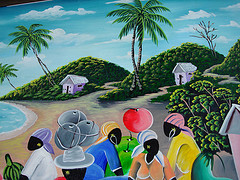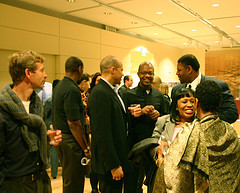Life Skills Development/Unit One/Heritage/Lesson
Here are some ideas which the original group had in an effort to represent the different small states
- Definition of heritage
- Influences of heritage on our lives
How heritage influences who we are, what we like and how we live
- Family tree
- Using the family tree work on how our heritage influences
Ethnic composition Festivals Food Religion
Contents
What does Heritage mean?
Heritage is what we recieve from the past. it shapes our present identity and provides insight for our future. It includes a range of activities such as stewardship, preservation, research, education and engagement. It encourages sensitivity to differing perspectives regarding objectives, ideas, places and traditions.
What ethnicities exist within Trinidad and Tobago?
Trinidad (but not Tobago) is ethnically heterogenous. This diversity includes Amerindians and people form Afica, India, Europe, China and the Middle East. Trinidadians and Tobagoians (the population of Tobago is almost 100 percent African descent) identify stringly with their home island and believe each other to be different culturally.
How it is that Trinidad is heterogeneous whilst Tobago remains homogenous?
Like their South American neighbours, the islands were inhabited by First Nation peoples, mainly the caribs and the Arawaks, until the majority was killed by Europeans after 1498, when Columbus set foot in the West Indies. Trinidad was in the hands of the Spanish from the 15th century until it was captured by the British in 1797. During the Spanish rule, very few Spanish people settled in trinidad. this was during the time of the French revolution, and many French fleeing the conflicts between the Royalians and the Republicans accepted the offer made by the Spanish to colonise Trinidad. French planter from the French islands of Martinique and Guadeloupe came during this time. When the British arrived, they met a country ruled by spanish with French speaking citizens. Tobago's history is very different from that of Trinidad. it changed hands many more times and was ruled at one time or another, by the Spanish, Dutch, French and British.
Trinidad became a British colony in 1802 and Tobago in 1814. They were enjoined administratively by the British in 1889 and then politically linked as a joint colony in 1890. With the abolition of slavery, and the refusal by the colonialists to pay the freed Africans a decent watge, a shortfall in labour for agriculture, was met by the Indians, who began to arrive in Trinidad in 1845, as indentured labourers. They emigrated from bengal, Bombay, Madras, Punjab and other provinces, and had both Muslims and Hindus among them. Chinese and Portuguese from the island of Maderia also came as indentured labourers. Early this century, many Syrian and Lebanese also came to Trinidad and played an important role in commerce. Up to the 19th century the islands like most colonies, developed as primary producers, supplying produce to be traded on the internatonal market, for the benefit of the colonialists. Traders from England, Scotland, germany, France and the United Staes, came to Trinidad as salesmen, entrepreneurs and bankers. Compared to the other islands, Trinidad was a wealthy, cosmopolitan country.
What is diaspora?
The term diaspora (Greek διασπορά, a scattering or sowing of seeds) is used (without capitalization) to refer to any people or ethnic population forced or induced to leave their traditional ethnic homelands, being dispersed throughout other parts of the world, and the ensuing developments in their dispersal and culture. We are part of several diasporas.
The Timeline for the East Indian, African and Chinese
Indian Timeline From 1500 BC - 2004 AD
- 1500 BC – The first wave of Aryan immigration into India.
- 322-182 BC – Mauryan dynasty, (the first historical dynasty in the history of India).
- 1526 AD – First battle of Panipat. Establishment of the Munghal Dynasty.
- 1600 AD – East India Company constituted.
- 1858 AD – India comes under direct rule of the British crown after failed Indian mutiny.
- 1885 AD – Indian National Congress founded.
- 1947 AD – India gains freedom and Jawaharlal Nehru is sworn in as the first Prime Minister of Independent India.
- 1947-48 AD – Hundreds of thousands die in widespread communal bloodshed after partition.
- 1948 AD – Mahatma Gandhi assassinated by Nathuram Godse.
- 1950 AD – India becomes a Republic. Dr. Rejendra Prasad is the first President of India.
- 1964 AD – Death of Minister Jawaharlal Nehru.
- 1971 AD –Twenty-two year treaty of friendship signed with Soviet Union.
- 1974 AD – India’s first atomic device exploded at Pokhran in Rajasthan
- 1984 AD – Indira Gandhi assasinated; son Rajiv Gandhi becomes Prime Minister.
- 1991 AD – Rajiv Gandhi assasinated.
- 1992 AD – Ayodhya demolished by Hindu fanatics; triggering widespread Hindu- Muslim violence.
- 1997 AD – I.K. Gujaral sworn in as Prime Minister.
- 1999 AD – Intense fighting in Kargil.
- 2004 AD – Manmohan Singh is sworn in as Prime Minister.
African Timeline From 4241 BC - 2005 AD
- 4241 BC – Invention of a fixed calendar in Egypt.
- 1370 - 1352 BC – Amenhotep (Akhenaton) and Nefertiti introduce Monotheism: Ra, the sun God.
- 1050 BC – Queen Sheba travels from Kush to visit Solomon.
- 332-283 BC – Conquest of Egypt by Alexander.
- 47-30 BC – Cleopatra VIII, Queen of the Nile, rules Egypt.
- 1 – 33AD – Life and times of Jesus Christ.
- 189 – 199 AD – Pope Victor I unifies Catholic Church.
- 622 AD – Prophet Muhammed journeys from Mecca to Medina
- 1490 AD – Askia Muhammed founds University of Sankore at Timbuktu.
- 1506 AD – King Alfonso of the Kongo ascends to the throne.
- 1590 AD– Songhay Empire destroyed by Moroccans.
- 1650 AD– Kingdom of Oya reaches its peak in West Africa
- 1652 AD – Dutch settlement. Dutch East India Co. establishes settlement at Cape Town.
- 1806 AD – British take control. Britain seizes and eventually annexes the Cape Colony. Forces Africans to work for white employers and place restrictions on their travel.
- 1910 AD - 'Union' of South Africa.
- 1948 AD: Apartheid. The National Party introduces apartheid (separateness) measures against blacks, Indian immigrants and those of mixed race.
- 1950s AD: Resistance to apartheid. Oliver Tambo and Nelson Mandela -- the African National Congress organizes a passive resistance campaign against apartheid and issues the Freedom Charter.
- 1961 AD: Independence. South Africa leaves the Commonwealth and becomes an independent republic.
- 1990 AD: Mandela freed. ANC leader Nelson Mandela is released after 27 years in captivity.
- 1994 AD: Mandela elected. World leaders gather on May 10 as Mandela is sworn in as president of the new South Africa.
- 1997 AD: New ANC Chief. Mandela, 79, steps down as ANC party leader and is replaced by 55-year-old Deputy President Thabo Mbeki
- 1999 AD: Elections. Second democratic elections. Thabo Mbeki (ANC) voted in.
- 2005 AD: Phumzile Mlambo-Ngcuka is appointed the new Deputy President.
Chinese Timeline From 12000 BC to 2004 AD
Ancient China
- 12000-2000 B.C Neolithic ca.
- 2100-1800 B.C Xia ca.
- 1700-1027 B.C Shang
- 1027-771 B.C Western Zhou
- 770-221 B.C Eastern Zhou
- 770-476 B.C Spring and Autum period
- 475-221 B.C Warring States period
Early Imperial China
- 221-207 B.C Qin
- 206 B.C. – 9 A.D. Western Han
- 9-25 A.D. Hsing (Wang Mang interregnum)
- 25-220 A.D Eastern Han
- 220-265 A.D Three Kingdoms
- 265-316A.D Western Chin
- 317-420 A.D. Eastern Chin
- 420-588 A.D Southern and Northern Dynasties
Classical Imperial China
- 580-618 A.D Sui
- 618-907 A.D Tang
- 907-960 A.D. Five Dynasties
- 907-979 A.D. Ten Kingdoms
- 960-1279 A.D Song.
- 916-1125 A.D Liao
- 1038-1227 A.D Western Xia.
- 1115-1234 A.D Jin.
Later Imperial China
- 1279-1368 A.D. Yuan
- 1368-1644 A.D .Ming
- 1644-1911 A.D. Quing
- 1911-1949AD Republic of China (mainland)
- 1949 A.D - Republic of China (Taiwan)
- 1949 A.D. – People's Republic of China
- 1949 – 1976 AD – Communist Period -- Maoist Phase
- 1976-2004 AD Communist- Post Mao phase
1. How have these different races contributed to societal development?
- Each ethnicity has contributed to the development of society in general. Their discoveries have benefited Trinidad and Tobago in particular. They came to Trinidad and Tobago and brought with them their cultures and traditions, which have been adapted into the Trinidadian culture.
| ETHNICITY | CONTRIBUTIONS TO SOCIETY |
|---|---|
| SYRIAN | i. The Alphabet |
| ii. Cuisine such as Kibbeh, Meswi, Tabbouleh and Kounafa. | |
| iii. Wheeled Vehicles. | |
| iv. Language | |
| EAST INDIAN | i. They introduced the custom of Playing Cards to the lower class members of society. |
| ii. Yoga. | |
| iii. The practice of surgery. | |
| iv. Musical Instruments such as the Harmonium, the Tabla, the Dholak and the Sitar. | |
| v. Festivals such as Phagwa, Divali and Eid Ul Fitr. | |
| vi. Cuisine such as Roti, Doubles, Saheena, Katchowrie, Barah, Anchar and Polourie. | |
| vii. Dances such as the Odissi and the Kathak. | |
| viii. Fashion such as the Sari and the Kurta/ Kurti. | |
| CHINESE | i. Clothing- the pien-fu, ch’ang-p’ao and the shen-i. |
| ii. Musical Instruments | |
| a. Bowed String Instrument- Erh | |
| b. Plucked String Instrument- Ruan | |
| c. Wind Instrument- sheng | |
| iii. The game of Whe Whe (now known as Play Whe). | |
| iv. Medicine- Acupuncture, Herbal medicine. | |
| v. The Kite. | |
| vi. Paper. | |
| vii. The Compass. | |
| viii. Silk | |
| ix. Umbrella | |
| x. Gunpowder | |
| xi. Seismographs (instruments that make an automatic record of the time, duration, direction, and intensity of earthquakes). | |
| AFRICAN | i. The Computed Axial Tomography (CAT) Scan. |
| ii. The First Heart Transplant. | |
| iii. Prattley’s Glue (only South-African invention to ever leave our orbit and travel to the moon; it did so in 1969 when the putty was used on the Apollo XI mission' s Eagle landing Craft). | |
| iv. The Speed Gun. | |
| v. The G5 long range artillery piece. | |
| vi. The Automatic popcorn vending machine. | |
| vii. The Swimming pool vacuum cleaner. | |
| viii. The Dolosse (A Dolos is an unusually shaped concrete block that can weigh up to 20 tonnes; they are designed to separate wave actions and protect the harbour walls and coastal installations). | |
| ix. 'Water wise gardening' (it improves plant growth while at the same time conserving water). |
2. What are some great achievements made by Trinidadians?
| NAME | ETHNICITY | ACHIEVEMENT |
|---|---|---|
| Sonny Ramadhin | East Indian | Legendary cricketer (First East Indian to represent West Indies.) |
| Dr. Rudranath Capildeo | East Indian | Politician and Mathematician |
| Adrian Cola Rienzi | East Indian | Trade Unionist, Politician and Lawyer. |
| Sundar Popo Bahora | East Indian | Singer - popularized Indian music. |
| John Lee Lum & Randolph Rust | Chinese | They partnered together financially to drill the country’s first well in Guayaguayare. |
| Solomon Hochoy | Chinese | Governor-General of Trinidad and Tobago |
| Dr. Eric Williams | African | Prime Minister of Trinidad and Tobago and renowned historian |
| Uriah Buzz Butler | African | Labour leader and Politician |
| Beryl Mc Burnie | African | First lady of dance |
| Jean Pierre | African | Most successful Caribbean woman in the field of Netball |

